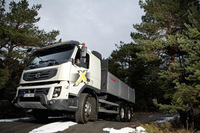Poor safety at construction sites

Every year, more than 300 people die in vehicle accidents at construction sites in the EU. It is usually the human factor that is the cause, which is why Volvo Trucks attaches considerable importance to safety issues in its training programme for construction drivers.
“The aim is to raise safety awareness among Europe’s drivers,” explains instructor An Paepen, responsible for Volvo’s driver training programme.
F?rat Gerçek is a qualified mechanical engineer who works as a driver trainer at Volvo Trucks in Turkey. He is visiting Gothenburg to learn about safe handling of vehicles on construction sites and will take his new skills back to Turkey and train other drivers.
The snow covers the landscape at the Volvo Trucks Demo Center in Gothenburg in Sweden. The approaching hill is steep and the surface is muddy. “Take your foot completely off the accelerator and brake pedals,” says An Paepen.
Gerçek lifts his feet off the pedals and the truck starts rolling backwards. Suddenly there is a slight jerk and the truck comes to a complete stop. “The truck automatically engages the brakes if it rolls backwards. This is a safety feature of the I-Shift transmission,” explains Paepen.
“Safety-consciousness is low among drivers in Turkey. Many drivers do not use a safety belt. At the same time, we have a very large construction sector. This combination means that a lot of accidents take place,” explains Gerçek.
According to Eurostat statistics, about 1,000 people die on European construction sites every year. One-third of these accidents involve vehicles, meaning well over 300 fatalities a year, but the number of injuries is several times greater.
“Construction sites are dangerous workplaces that demand a good deal of skill on the part of the driver. Conditions may be slippery, narrow or steep. Despite this, drivers often tend to operate on ‘autopilot’, without thinking. This is when things get dangerous and accidents happen,” notes Paepen.
Last year, Volvo Trucks introduced a new construction truck, the Volvo FMX. In conjunction with its launch, the company rolled out a new tailor-made training programme for construction drivers. Much of the course content deals with safety.
“We felt we could make a difference in this area,” says Paepen.
The course includes driving techniques practised on the test track alternated with theory lessons and group discussions.
“We're aiming to increase risk awareness, not least through dialogue. Many drivers are highly experienced. By giving them the opportunity to talk about their experiences, we harness their know-how and continuously update the course material,” explains Paepen.
According to Eurostat, the most common type of vehicle accident at construction sites is running into somebody. The reason is usually poor visibility.
“It’s vital that everyone wears high-visibility protective clothing, and that pedestrians avoid walking where trucks drive, load and unload.”
The reversing signal blares across the demo track. Inside the cab, Gerçek has a commanding view to the rear via the rear-view mirrors and a TV display that pops up from the instrument panel.
“In many countries, it’s a legal requirement for trucks to be fitted with a reversing screen. That’s a positive development,” says Paepen.
Gerçek explains that one of the most common accident types in Turkey is truck roll-overs. According to Eurostat, this is the reason behind one in five fatal accidents (20%) involving vehicles. The driver training course gives Gerçek knowledge and tips on how to avoid such accidents. The most important parameter is to ensure that the load is always evenly distributed.
“Time is always scarce at construction sites, and everything moves quickly. However, it’s important that the driver and the loader take the time to co-operate and don't cut corners,” he says.
On the test track, Paepen continues instructing Gerçek on the best way to handle I-Shift, a 12-speed manual gearbox with an automated gearchanging system that is fitted to most Volvo FMX trucks.
“With I-Shift, the driver is free to focus entirely on the actual driving and has oversight of what’s happening outside the cab,” explains Paepen.
At the construction site, there is always a risk of bogging down with a heavily laden truck. Vehicle downtime costs money – and can give rise to dangerous situations.
“When rescuing a truck that is stuck, considerable forces are involved. The towing line may snap and slash bystanders. This is absolutely lethal,” says Paepen.
I-Shift makes it possible for the driver to rock the truck free without outside help.
“With the I-Shift transmission, you can find the drag point in the transmission as you press the accelerator. By releasing the accelerator just as you reach the drag point and then letting the truck roll back slightly, you create a back-and-forth rocking motion. After a while, this rocking movement builds up sufficient kinetic energy to roll the truck over the obstacle,” explains Paepen.
Gerçek stops the truck. The day’s training session is over. Tomorrow there will be more driving techniques and more theory.
“This is a great course. I’m gaining a lot of knowledge that I can take back to Turkey,” he says.

